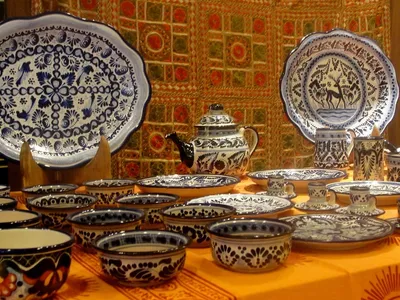
31 Mexican Crafts that Bridge Art and Culture
31 Mexican Crafts that Bridge Art and Culture
Mexican crafts comprise a world of varied and colorful items with decorative and practical uses made by its many indigenous peoples.
These communities have ancestrally worked clay, stone, wood, natural fibers, textiles, metals, and other materials to create the best crafts in Mexico.
Among these are dolls, toys, ornaments, masks, and pieces for daily home use, such as footwear and typical clothing.
In today’s article, we’ll dive into the 31 best Mexican crafts representing Mexico and its people. Let’s begin!
TOP 31 Mexican Crafts
1. Talavera from Puebla
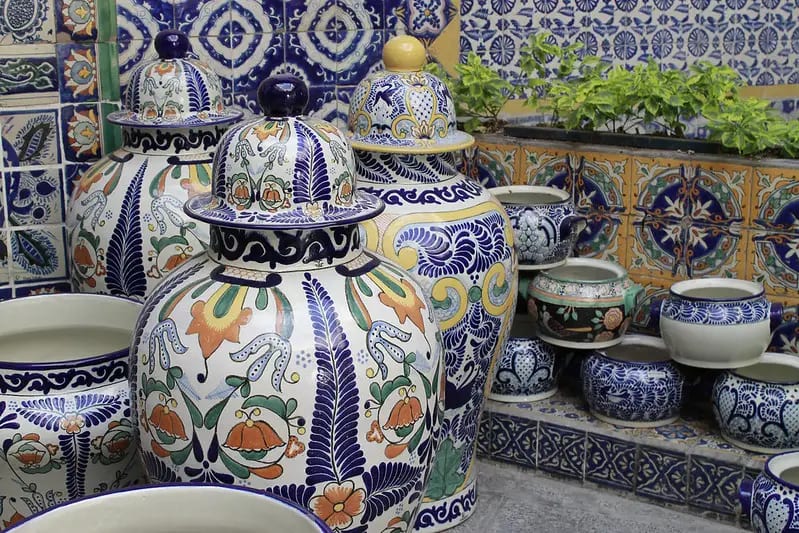
Let’s start with ceramics and Talavera poblana. The art of majolica pottery came to Mexico from Spain.
The first artisans settled in Puebla in the 16th century, starting a tradition now famous thanks to the quality of the local clays and the talent of the artisans.
To distinguish it from the Spanish Talavera, it was called Talavera Poblana, a denomination of origin that identifies the products elaborated by the traditional methods of 5 centuries ago.
Talavera poblana is characterized by its white vitreous finish and uses only six colors: blue, black, yellow, green, orange, and pale violet (mauve), all derived from natural pigments.
Each piece is turned and painted by hand (the paint can be felt by touch). The glaze contains lead and tin, according to the practice applied since colonial times.
The localities producing authentic Talavera Poblana are Puebla City, Atlixco, Tecali de Herrera, and Cholula.
The Museo de la Talavera Alarca, which exhibits the most emblematic works of this technique, is located at Lateral Sur Recta a Cholula, 3510, Puebla.
2. Huichol stamen paintings and bead art
The indigenous Huichol or Wixárikas have collected peyote since ancient times, and it is believed that the consumption of this hallucinogenic cactus has to do with the origin of their artistic expressions.
The Huicholes took refuge in the Sierra Madre Occidental, especially in Nayarit, as well as the mountainous zones of Jalisco, Zacatecas, and Durango, after the arrival of the Spaniards.
Depending on the design’s complexity, a table’s elaboration could take weeks.
Nevertheless, they continue to elaborate their paintings or worsted boards, in which they weave the multicolored threads on a wax and resin base, to communicate artistically with the gods and to present daily images of their life.
Huichol artists painted with yarns that were initially the stamens obtained directly from the wool fleeces of sheep. Now they use commercial yarns.
Another facet developed by Huichol art is the work with beads instead of threads, taking advantage of the diversity and colorfulness of the commercial pieces.
This method elaborates striking designs such as animal heads and masks.
3. Cueras from Tamaulipas
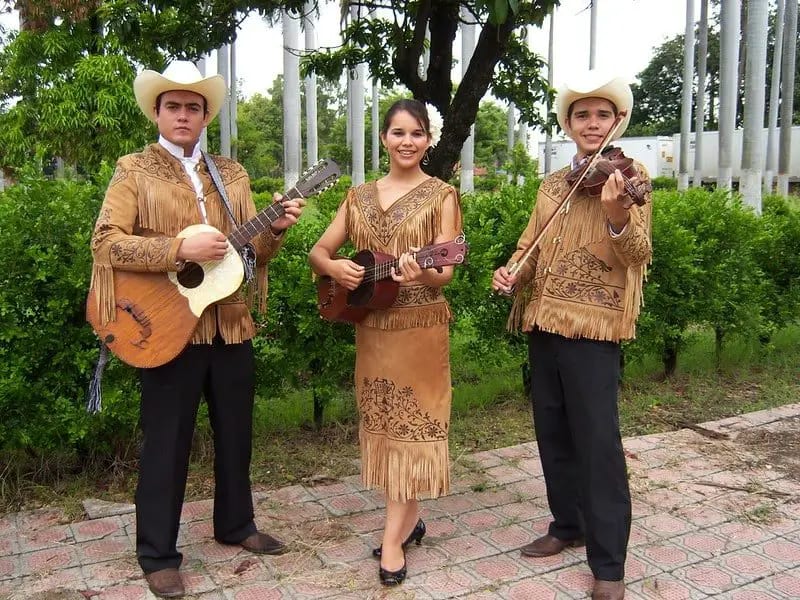
Among the Mexican crafts of Tamaulipas, the most emblematic is the cuera, a jacket originating in Ciudad Tula.
It is made with calfskin or deer suede and is decorated with white engravings and long bangs on the back, front, sleeves, and border.
In the early 1960s, it was adopted as the regional costume of Tamaulipas. The female garment consists of a jacket and skirt.
The leather is handcrafted and takes several days to make. The leather is tanned and treated, so it adopts its typical beige color, and the ornaments, generally white, are glued or sewn to the piece.
In 2010 the Cuerudo Tamaulipeco was inaugurated in Ciudad Victoria, a monumental bronze sculpture in which its artist, Elizabeth Pesquera Caballero, depicted a rider in leather on a horse with raised forequarters.
The song, El Cuerudo Tamaulipeco, by Professor Francisco Flores, is a sort of regional anthem of Tamaulipas.
4. Black pottery from Oaxaca
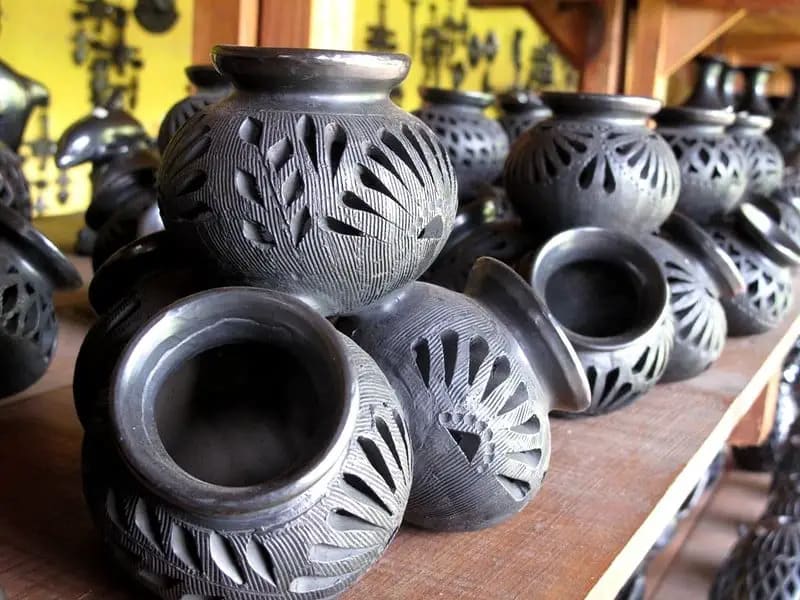
The most distinctive pottery of Oaxaca is black clay.
Although the Zapotecs and Mixtecs already worked matte gray pottery during pre-Hispanic times, the current black pottery is due to a discovery in the mid-twentieth century by Doña Rosa Real Mateo de Nieto.
Doña Rosa discovered that if the pottery was heated in a lower fire and polished with a quartz stone before drying completely, it acquired the metallic shine and tone that characterizes Oaxacan black pottery.
The capital of black clay in Oaxaca is the town of San Bartolo Coyotepec, 13 km from Oaxaca City.
Handicrafts can be purchased directly from workshops or local artisan markets.
Most of the ceramic workshops in this town, including Doña Rosa’s workshop, are now run by her descendants.
The black clay objects are slower to produce, and their fragility has led them to be considered decorative pieces.
In San Bartolo Coyotepec is the State Museum of Popular Art of Oaxaca, which dedicates one of its rooms to black clay.
5. El Arbol de la Vida (The Tree of Life)
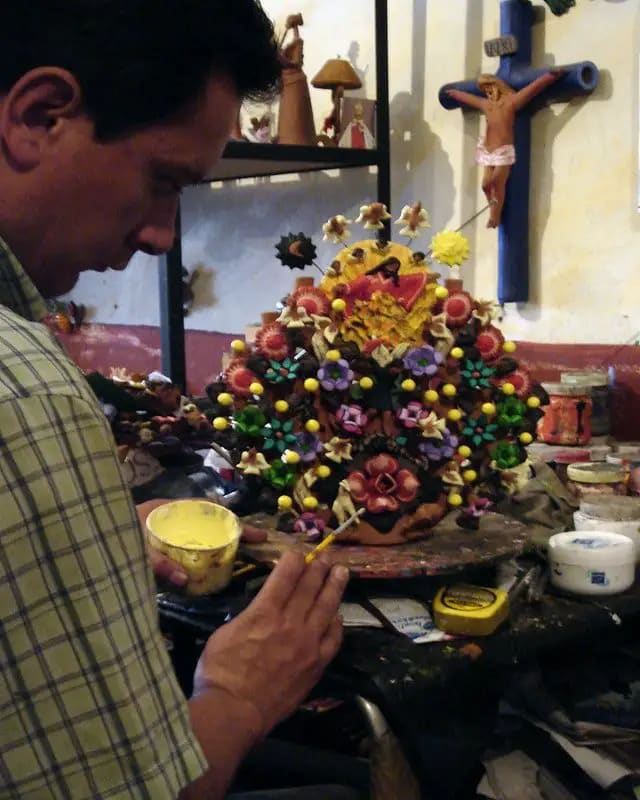
The tree of life is a concept in many mythologies and philosophies.
Still, Mexico adopted a particular conception in the form of a beautiful, laborious and colorful clay sculpture.
During the colony, they were inspired by biblical themes and were instruments to teach Christianity to the native population, but nowadays, trees of life are dictated by other themes.
It is one of the main crafts of Mexico whose elaboration originated in the town of Metepec, near Toluca.
The trees of life were made for religious purposes until the middle of the 20th century.
A large piece could take months or years to be finished, but the beginning of its elaboration as an object of adornment took the craftsmanship out of its strictly biblical scope.
In the current handicrafts market of Metepec, there is a fantastic collection of trees of life, which shows the artistic and patient work of the local families.
6. Rebozos (shawls)
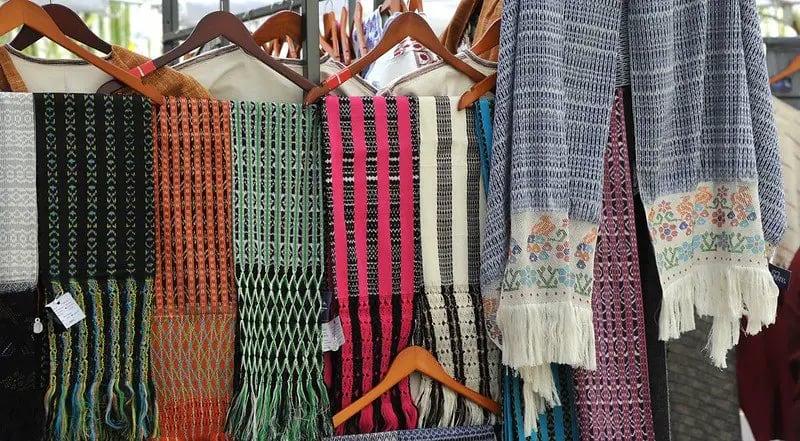
Although indigenous peoples had used the rebozo during pre-Columbian times, it became famous as a complement to women’s clothing to enter Catholic temples.
The “rebozo,” a word that dates back to 1562, is a square piece made mainly of cotton, silk, wool, and artisela (synthetic silk), measuring up to 3 meters long.
The garment is used in Mexico, Central, and South America, symbolizing Mexicanness immortalized in some of Frida Kahlo’s paintings.
The main Mexican states where rebozos are made are San Luis Potosí, Mexico, Michoacán, Oaxaca, and Querétaro.
The most famous are those made in the town of Santa María del Río in Potosí, the cradle of the bolita shawl, where they are made by skilled Otomí and Guachichil weavers.
Making a high-quality rebozo can take up to 2 months, and they are colored with natural pigments—Indigo for blue, cochineal for carmine, and old iron for black.
The rebozo can be a feminine garment like a shawl or a scarf, but also a clothesline, purse, handkerchief, shroud, or ergonomic instrument for carrying babies.
7. Serapes
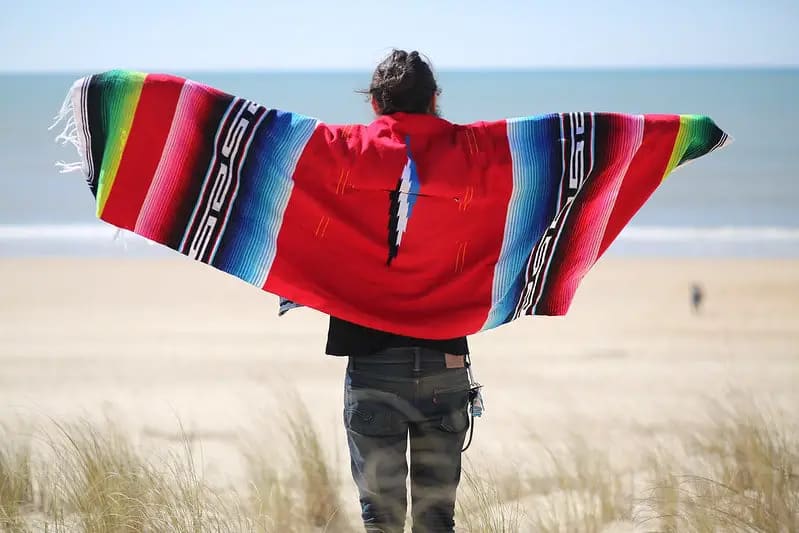
The serape represents Mexican men, the same as the rebozo for women.
It is a garment similar to the Andean poncho to protect from the cold and rain, but it can also be an improvised rug or carpet.
Although it is of great tradition in several Mexican regions, it emerged in Saltillo and is more common in the north.
Fans of westerns will surely remember the serape worn by Clint Eastwood in the movie, For a Fistful of Dollars.
The serapes are made with thick yarns, and before the arrival of industrial dyes, their coloring was with natural handmade pigments.
The primary materials used are cotton and wool. The loom that arrived with the Spaniards helped increase production and interweave stripes of different colors more easily.
8. Silverware

Mexico’s silver mines swelled the coffers of the Spanish royal house.
During the viceregal era, they made immense personal fortunes, such as that of Pedro Romero de Terreros, Count of Regla, one of the wealthiest men in the world in the 18th century.
They also left the apprenticeship of the silversmith’s trade, a tradition in the artisan work of silver that was maintained after the mines were exhausted.
The silver objects of the Magical Town of Taxco Guerrero have national and international fame among the handicrafts of Mexico.
Every Saturday, the silver market fills the historic center’s streets with vendors offering rings, earrings, bracelets, necklaces, chains, anklets, and other silver pieces at “popular jewelry” prices.
During the last week of November, the National Silver Fair is held in Taxco, in which Taxco and Mexican silversmiths compete with their pieces to see which ones receive the best awards in design and execution.
9. Hammocks, a tradition of Mexican crafts
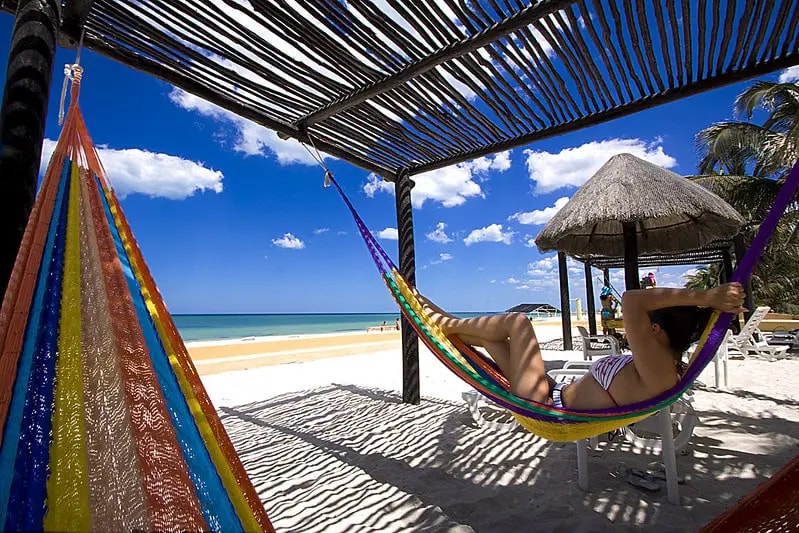
No Yucatecan home is without a hammock, a Caribbean invention of unknown origin believed to have arrived in Yucatan 200 years before the conquest.
Nowadays, they are made of artificial materials such as polypropylene, but originally they were only made of natural fibers such as sisal and cotton.
The Henequen Era in Yucatan is usually associated with the large haciendas that cultivated the henequen plant and extracted the natural fiber to manufacture ropes for mooring ships, sacks, and other things to work on the mainland.
The Magical Town of Sisal is still the basis of the Yucatecan hammock.
The Yucatecan artisans of Tixcocob, Chumayel, Teabo, and other communities have fantastic skill at handling the frame and the two needles required to make a one-color, multicolor, children’s, family, individual, or personalized hammock.
Depending on the size and complexity of the design, it takes between 1 and 2 weeks to make an excellent and beautiful hammock.
10. Amber from Chiapas
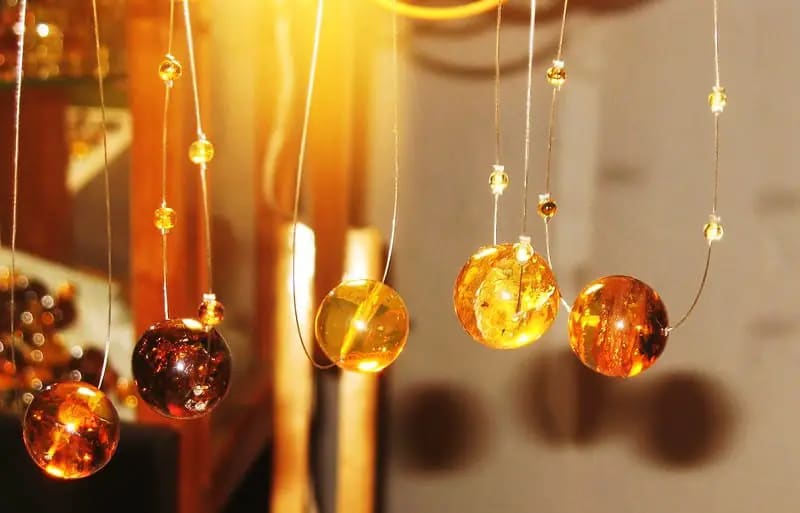
Amber is a fossilized resin from the remains of coniferous trees, considered a semi-precious stone.
It is rather a rarity, and due to its characteristics, it is classified with different names according to its origin, the most known being Dominican amber, Mexican amber, Baltic amber, and Spanish amber.
Although there are yellow, white, greenish, and many other varieties, it is predominantly light brown.
The primary source of amber in Mexico is Chiapas, and arguably the national amber capital is San Cristobal de las Casas.
Chiapas amber was formed from forests of the Tertiary era 30 million years ago and is the hardest in the world, a quality that, together with its wide variety of colors, has given it international prestige for carving.
Chiapaneco carving is handmade, which increases its artistic value.
The Amber Museum of Chiapas is located in the former Convent of La Merced de Ciudad Real, a historic 16th-century building in San Cristobal de las Casas, which was the first establishment of the Mercedarian order in the New World.
It exhibits some 350 pieces, both rough and carved.
11. Jipi palm weavings from Campeche
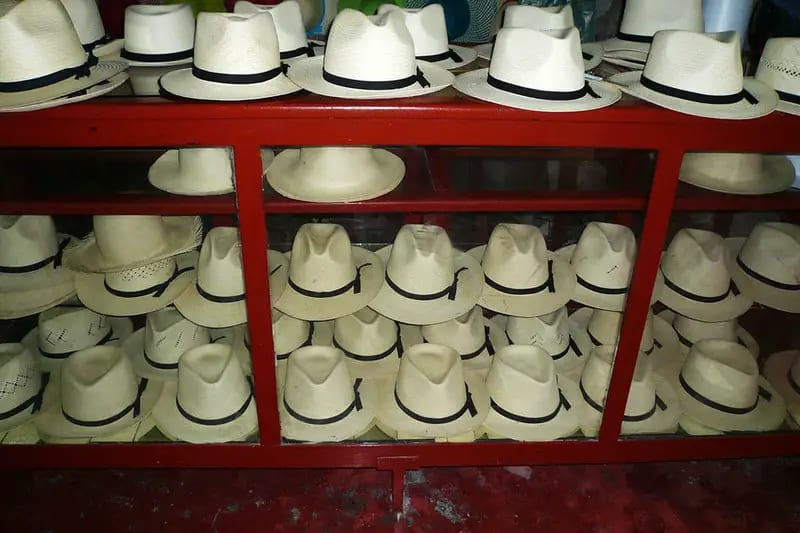
Many people believe that the famous Panama hat is so called because it originated in the canal republic.
The truth is that it is an Ecuadorian jipi palm hat (for which they are also called jipijapa) that adopted its current name because of the thousands imported from Ecuador during the canal’s construction.
One of these hats was used by former U.S. President Teddy Roosevelt.
Its function was and still is to protect the workers from the hot tropical sun.
The jipi palm is also skillfully worked in Campeche, specifically in the towns of Becal, San Nicolás, Santa Cruz, and Tankuché.
Campeche artisans in these towns make Panama hats and other confections from the jipi palm.
The work is not easy. The leaves must be carefully selected, and the artistry requires excellent manual dexterity.
The most curious thing is that a good part of the creative process is carried out in caves since, in these natural spaces, the humidity and temperature conditions facilitate the manipulation of the fibers.
12. Charro hats from Jalisco
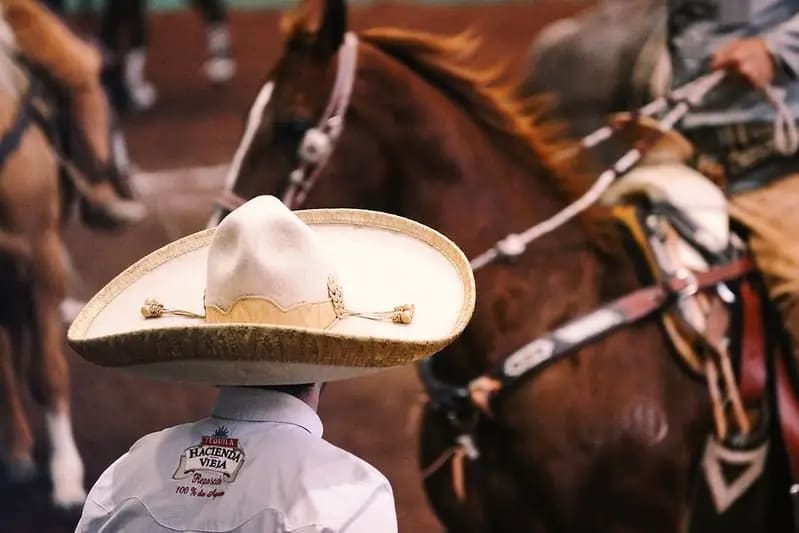
These hats have been popularized as souvenirs by the mariachi, who use the typical Mexican charro hat in their costumes.
Their origin is Spanish, particularly from Andalusia, where wealthy landowners used them.
The charro hats are a popular piece in the haciendas of Mexico for protection from the sun, wind, and dust.
However, its wide brim has many other benefits as an instrument to stoke and extinguish a campfire, stun a snake or cushion a blow in a fall.
Hats can be made with wool felt, hare, and other animal leather, which despite being more durable, are also heavier. Those made with wheat and palm straw are cooler and lighter.
The authentic charro hat has a wide brim raised at the back and four concavities called “pedradas” in the crown, which provides esthetics and resistance.
It is common to decorate them with “toquillas” and trimmings.
13. Olinala boxes
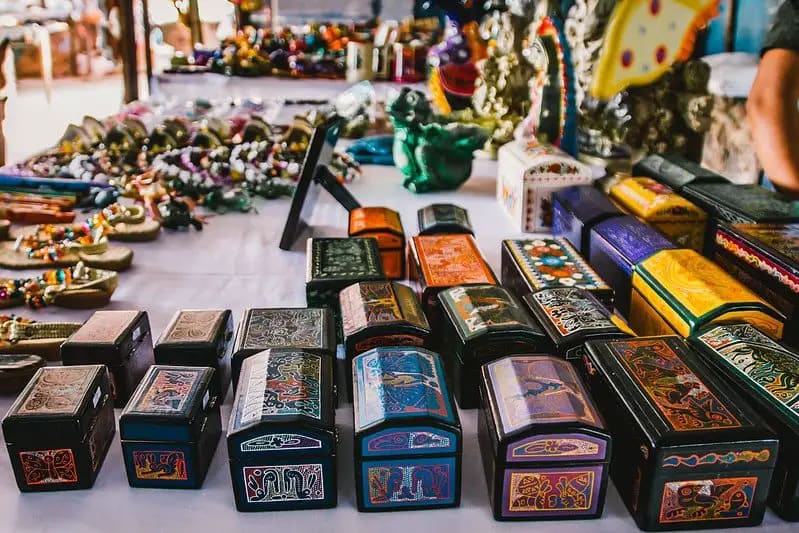
These cute little boxes are a tradition with pre-Hispanic contributions and a great impulse in the XVII century.
Artisans of Olinala Guerrero learned the art of furniture making.
They made trunks, chests, and boxes of excellent artisan value, especially for their paintings with lacquers and the beauty and elegance of their hinges, ironworks, plates, and straps.
The elaboration of a box is a delicate process with about 30 steps, including the realization of engravings, paintings, and the application of lacquers.
Each box is a unique and unrepeatable work.
The base of the lacquers is chia oil that acts as a binder mixed with three minerals: dolomite called Toltec, an iron oxide known as tecoxtle, and calcite called texicaltecriollo.
The wood used is that of the lináloe tree, also used to make other decorative and practical objects such as trays, fruit bowls, bread baskets, trunks, and jewelry boxes.
Each artisan has evolved with their techniques in elaborating the small boxes of Olinala, the greatest handicraft heritage of Guerrero.
14. Copper crafts from Santa Clara del Cobre
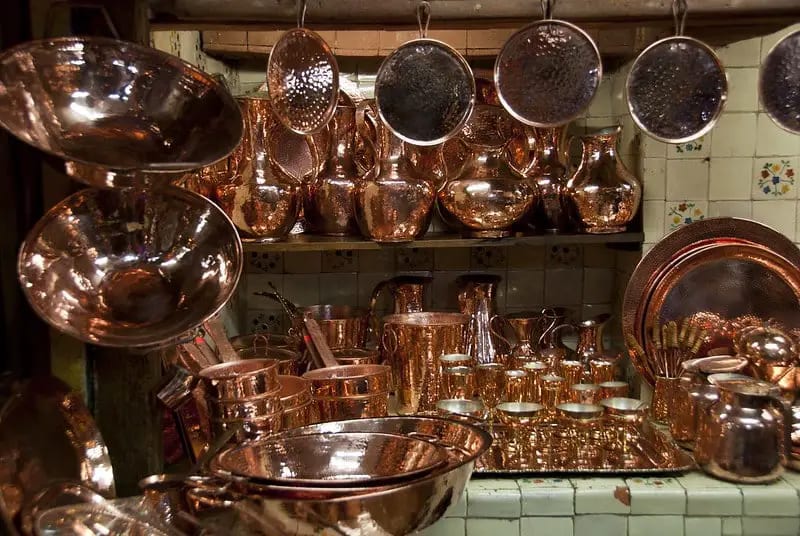
Santa Clara del Cobre is a magical Michoacan town in the municipality of Salvador Escalante.
The locals learned hammering metals in pre-Hispanic times, although Bishop Vasco de Quiroga, in the 16th century, was the great promoter of copper activity.
From the main square, you can feel the overwhelming presence of the reddish metal in Santa Clara del Cobre, with the enormous copper pot in the center of the kiosk and the sheets of the material that form the roof and create a beautiful effect when hit by sunshine.
The ancient Purepecha artisans hammered the copper with stones, and although other tools are now used, the atmosphere in the workshops has changed very little.
Ornamental and household pieces are exhibited in the National Copper Fair held in mid-August.
In the National Copper Museum, on Morelos Avenue and Pino Suarez, there is a sample of representative objects made with traditional techniques.
15. Tlahuelompa Bells, unique Mexican Crafts
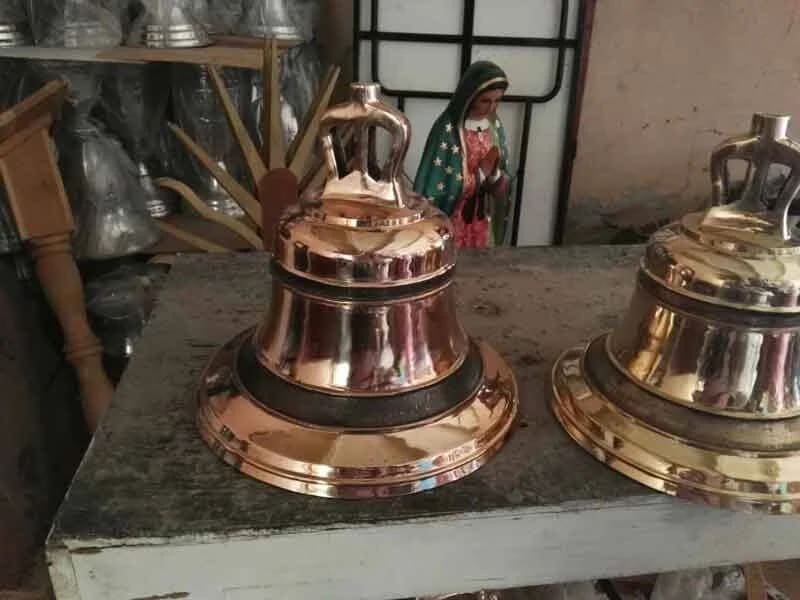
One of the unique Mexican crafts is the bells made in this town in the highlands of Hidalgo.
This small mountain community is known as the Valley of the Bells because of the resonant instruments they make in tin, bronze, and copper from clay molds.
They also produce pots and other household items.
The metal is melted and poured into a clay mold. The following day, the metal is demolded to obtain a “raw” bell, which is finished after being cleaned, burnished, and polished.
The beautiful tones are obtained by changing the amount of each metal in the mixture to be melted; a silver color indicates the presence of more bronze, and a golden or reddish tone suggests a greater amount of copper.
In Tlahuelompa, large bells are made to be rung in churches and other places, as well as smaller versions for decorative purposes.
Other fascinating craft traditions in Tlahuelompa are the manufacture of religious images and the elaboration of fruit wines.
16. Green pottery from Santa María Atzompa, Oaxaca
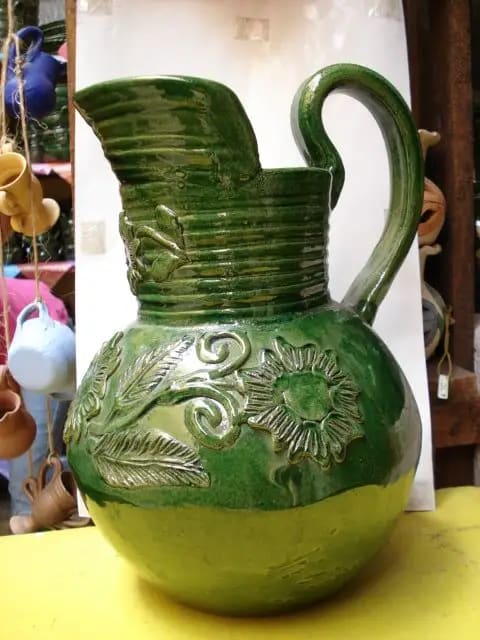
The black clay tradition of San Bartolo Coyotepec Oaxaca joins the green clay of Santa María Atzompa, a municipality in the central valleys whose word Atzompa means in Nahua: “at the top of the water.”
The local pottery is distinguished by its green glaze and is a less porous ceramic that is easier to clean.
This is the most important pottery product of Santa María Atzompa, but not the only one, since they also make pieces with amber glaze and other colors.
The designs are made with the techniques of pastillage and fretwork.
The articles include tableware, vases, pitchers, jugs, casseroles, pots, chirmoleras, toys, and other decorative objects.
After being molded and fired, the piece receives a greta bath, a mixture of lead oxide and silica that gives it the green-glazed appearance that characterizes ceramics.
Santa María Atzompa is a picturesque town of almost 6,000 inhabitants 8 km west of Oaxaca City.
Other attractions include its rustic church with two towers and the small square with a kiosk.
17. Guayaberas of Yucatan
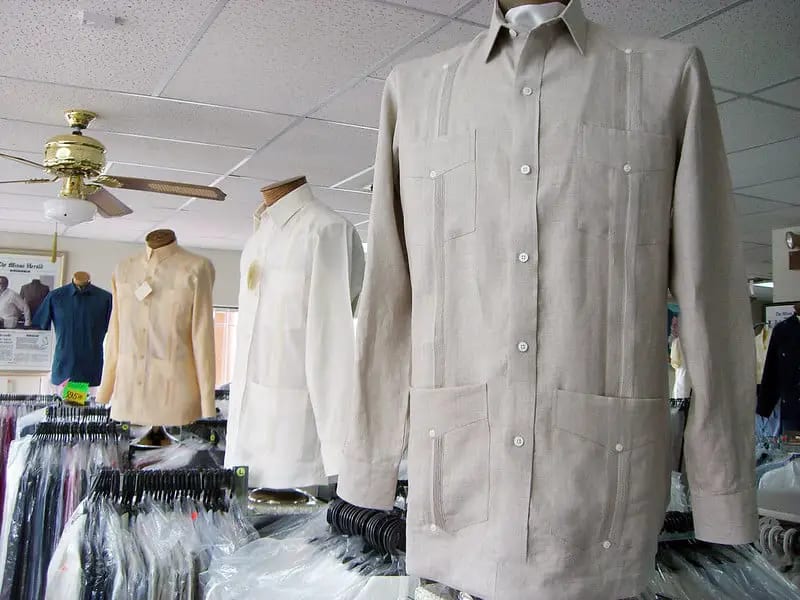
Several versions are known of the origin of the guayabera. One says it comes from Cuba, where a tailor from Sancti Spíritus designed it so men could carry enough tobacco.
According to this version, the peasants who lived in the basin of the Yayabo River near Sancti Spíritus began to call it “yayabera,” and from there, the name migrated to guayabera because of its usefulness in carrying guavas.
They are made with long sleeves and short sleeves.
Another story states that the guayabera came from the Yucatan peninsula, then went to the Caribbean islands and the Philippines.
In any case, what distinguishes this practical masculine shirt is its use outside the pants, its “alforzado” (folded vertical lines), and its four wide pockets, two on the breastplate and two on the skirts.
It is a traditional garment in Yucatan because of its lightness and comfort, which makes it great for tropical climates.
18. Paracho Guitars
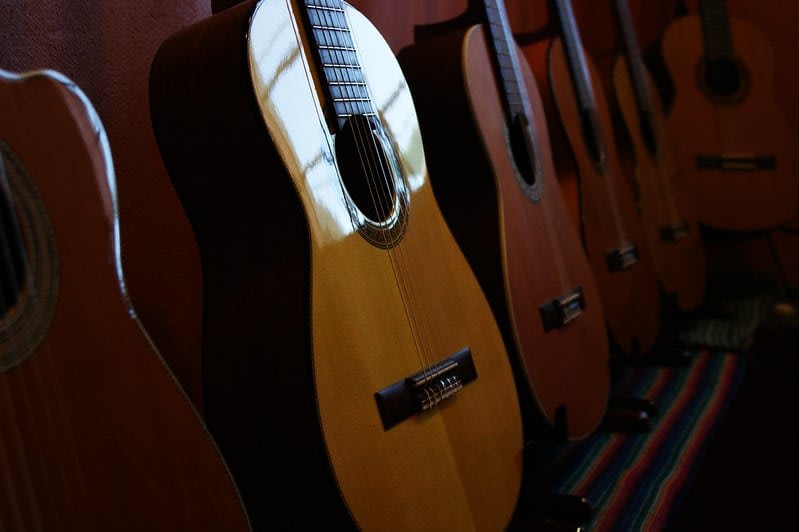
Life in Paracho Michoacan revolves around the production of wooden musical instruments, especially guitars, of which about 20,000 are handcrafted every month, in a tradition that goes back more than five centuries.
Other wooden musical instruments manufactured by local lute makers include guitarrones, mandolins, violins, violoncellos, lutes, double basses, tricordias, charangos, and requintos.
Paracho guitars are made of different national and imported woods, such as cedar, rosewood, fir, and cypress.
They also make miniatures that involve laborious artistic work and other wooden items such as toys, bookcases, dining rooms, kitchen utensils, and furniture.
During the first two weeks of August, the International Guitar Fair is held, which includes a guitar festival, a builders’ contest, a handicrafts market, and a gastronomic fair.
Most of Paracho’s guitar production is exported to Asia, Europe, and North America.
19. Huipiles of Yucatan
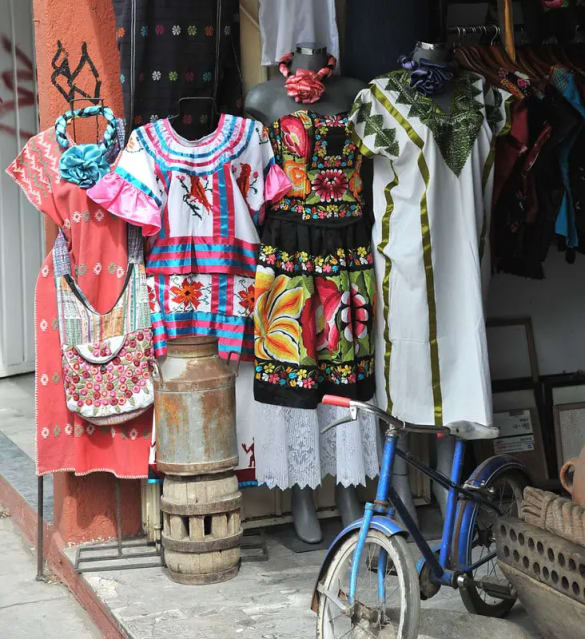
The Spanish Christian evangelists found women with naked torsos on their arrival in Yucatan in the 16th century.
As this was not well seen, they forced the indigenous women to wear a coarse linen nightgown with two holes for the arms and one for the neck, called güipil.
Thus was born the Yucatecan huipil. Currently, the typical regional costume is made up of 3 pieces, also called the Yucatecan terno.
The three pieces are the doublet, which looks like a square neckline and has cross-stitch embroidered ornaments; the huipil or hipil, a light dress with embroidery on the lower part that reaches the knees; and the fustan, a piece longer than the hipil that is tied at the waist.
The attire is completed with a “chongo” hairstyle fixed with a comb and adorned with natural flowers, earrings, and gold and coral filigree rosaries.
The huipil is also used in other Mexican regions such as Querétaro, Puebla, and the Huasteca.
It is a colorful, fresh, and very comfortable garment, traditionally white with colorful ornaments.
20. Mexican crafts: Huaraches
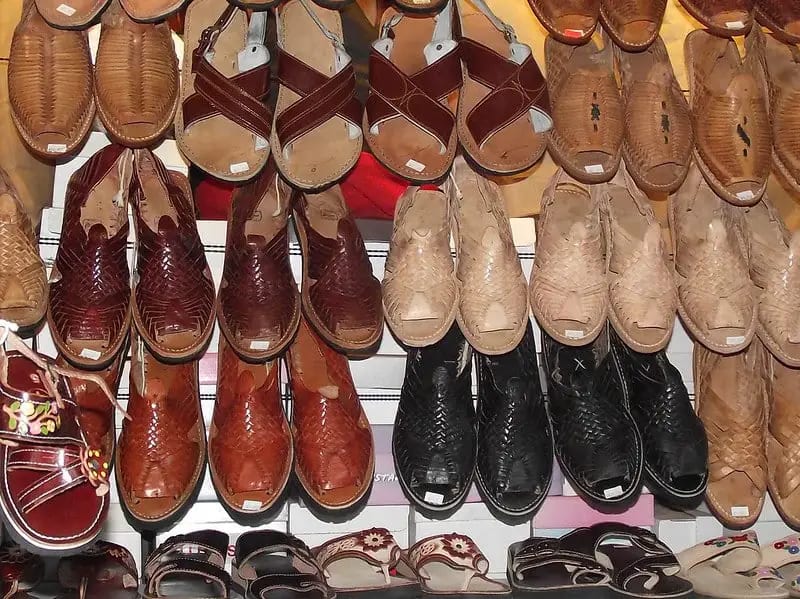
Huaraches are Mexican garments that emerged from the syncretism between pre-Columbian and European cultures brought by the conquistadors.
They are popular sandals that the pre-Hispanic Indians used to make with natural fibers until the Spaniards arrived with cattle and began to make them with leather straps as they are today.
The huarache is a shoe worn mainly by peasant populations in states such as Michoacán, Jalisco, Yucatán, and Colima.
It is also the sandal worn by religious orders such as the Franciscans. The word “huarache” comes from the Purépecha word “kwarachi.”
Other advantages of huaraches are their economy as footwear because they can be repaired several times.
The sole material has also evolved from rope and cowhide to synthetic rubber.
They have their equivalent in Mexican gastronomy with the huarache, a corn dough cake similar to the sole of the sandal, which is filled with beans, meats, and vegetables garnished with cheese and salsa.
21. Mexican Masks
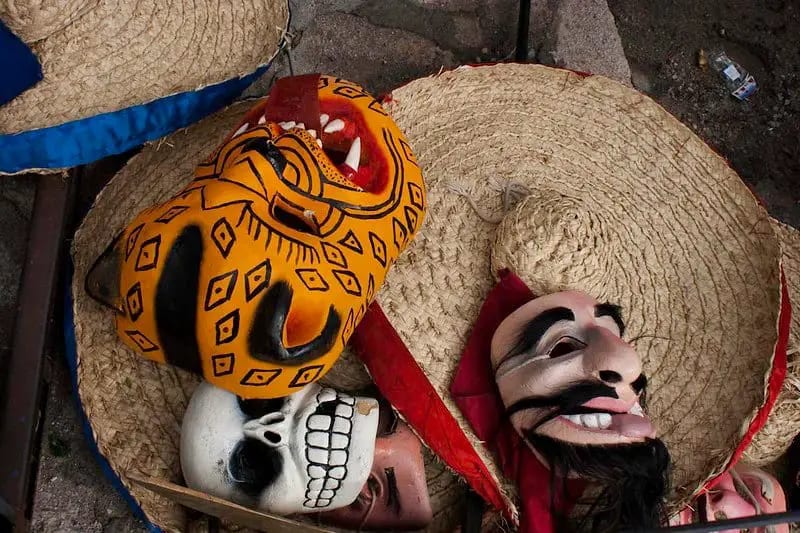
The art of the Mexican mask had pre-Hispanic origins when they began to be used in ceremonies, rites, and traditional dances.
It transcended culturally until contemporary times for the masks used in wrestling (Lucha libre), one of the most popular sports in the country.
The primary materials used in elaborating the masks are wood, clay, leather, cardboard, cloth, and paper-mâché.
The masks are part of the attire used by dancers in typical Mexican choreographies, such as the Parachicos of the Fiesta Grande of Chiapa de Corzo, the Danza del Caballito Blanco of Nacajuca (Tabasco), the Chinelos of Morelos, and the Fariseos of Sonora.
The collection of more than 1300 pieces from the National Museum of the Mask in San Luis Potosi is the largest in the country.
22. Rarámuri basketry
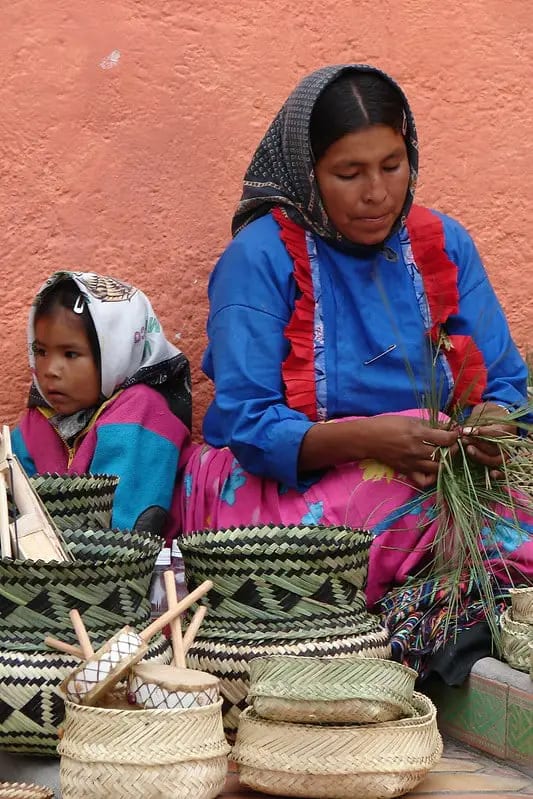
The Rarámuris or Tarahumaras live in the abysmal spaces of the Copper Canyon and the Sierra Tarahumara in Chihuahua, where they developed a particular religious syncretism and a culture with peculiar features, such as the game of ball races.
Among the Rarámuri handicraft products, basketry stands out, acquired by travelers who cross the Copper Canyon aboard the El Chepe train.
The baskets are made with palmilla and sotol fibers, a plant similar to the maguey that grows in the Baja Tarahumara at 600 meters above sea level.
They also work with leaves from pine trees that grow in the Alta Tarahumara at 1800 to 2800 meters above sea level.
The work begins by preparing the sotol and palmilla fibers and cutting the leaves into strips of different widths.
A circular or square base is made, and the piece is finished by weaving the twill in different variations. The weaving can be single or double.
23. Mazahua embroidery
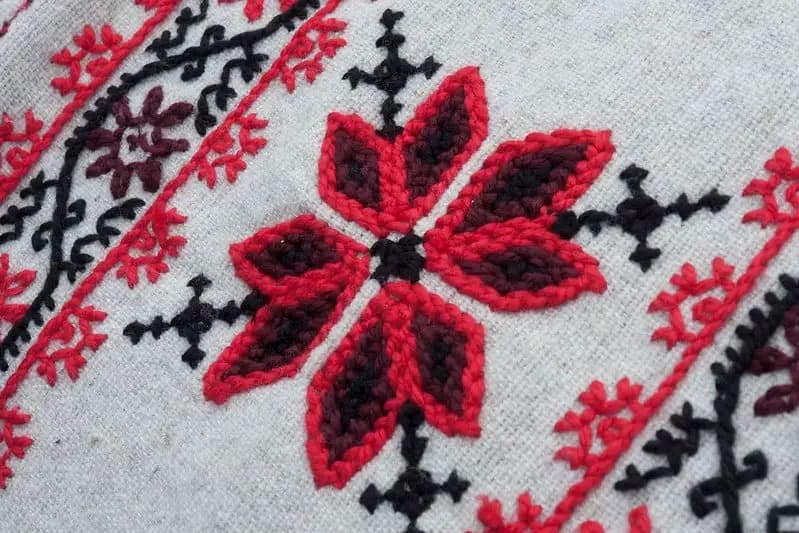
The Mazahua is the most numerous indigenous people in the valleys of central Mexico and Michoacan who live in rural mountain areas.
Their main handicraft product is wool and cross-stitch embroidery, with motifs that include plants, animals, and fretwork.
They also elaborate with great-skill blankets, quilts, quexquemiles, sashes, vests, backpacks, shawls, covers, and other garments.
In addition to cross stitch, they use embroidery with loin stitch, basting, two-needle embroidery, pepenado, pata de gallo, and careado, among others.
The embroideries are mainly made in wool, cotton, and blanket.
Each Mazahua community has its handicraft specialty. For example, the town of San Felipe Santiago (municipality of Villa de Allende) is practically the only one that works fine blanket embroidery.
Although traditional embroidery remains (flowers, horses, deer, and the Mazahua star), artisans have opened up to modernity.
It is common to find designs with soccer team logos and cartoon characters.
24. Catrinas of Capula, Michoacan

The catrina is a skull figure created by the illustrator, caricaturist, and engraver José Guadalupe Posada.
She was baptized with this name by his young friend, Diego Rivera.
During the second half of the 19th century, writings and pamphlets that criticized and mocked the characters of the privileged classes became popular in Mexico, presenting them as bodies dressed in expensive clothes and skull faces.
The word catrín became synonymous with the refined English dandy, and the catrina became the equivalent female character.
The Michoacan town of Capula adopted the artisan tradition of making striking catrinas, whose skeletal figures are made of clay and dressed in different attire, including huipiles, long dresses, and wide-brimmed hats.
Visitors to the town are greeted by a monumental catrina wearing a fancy colonial dress, a hat adorned with flowers, and a shawl in the shape of a feathered serpent.
For the Day of the Dead, the Capula Catrina Fair is held, an occasion in which local artisans strive to present the most faithful skeletons and the most original costumes.
25. Piteado of Colotlán, Jalisco
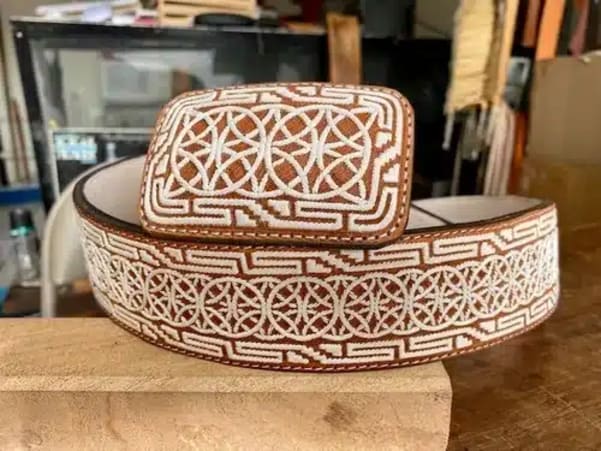
The “piteado” is a handcrafted work that consists of embroidery with pita (thread obtained from maguey fiber) on a leather base, using decorative patterns.
The technique is applied to manufacture different leather articles such as saddles, belts, footwear, and headbands.
Typical embroideries are animals, flowers, motifs related to charrería, and pre-Hispanic and other cultural symbols.
The piteado is associated with the charro and is also worked in other states, although not necessarily using pita thread.
The Jalisco town of Colotlán is called the “world capital of piteado.”
It is a beautiful art threatened by the competition of the industrial piteado made with machines and commercial threads, which produce pieces that, by their resemblance, can be confused with authentically handmade confections.
Another factor that threatens the conservation of piteado in Colotlán and practically in Mexico is the lack of interest of young people in learning Mexican crafts whose teachings have been transmitted from generation to generation.
Two great enthusiasts of the piteado of Colotlán have been the famous Mexican singer Vicente Fernández and the former president, Luis Echeverría.
26. Mexican crafts: Palm Dolls
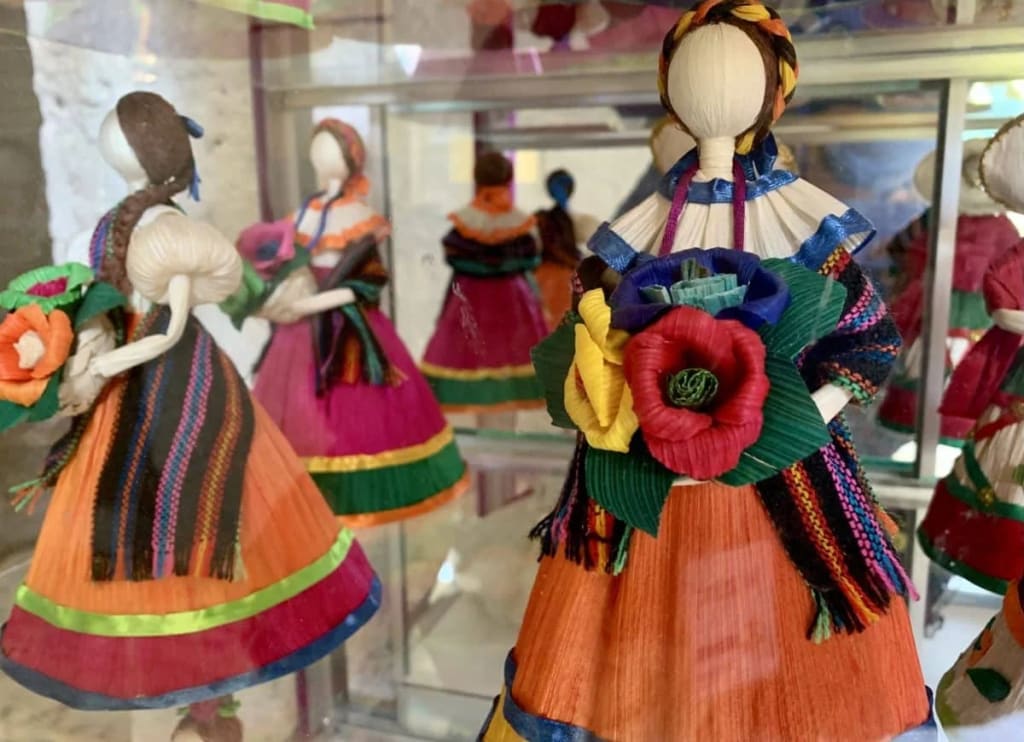
Mexican doll art comes from pre-Hispanic Mexico, and some continue to be elaborated as the Pames dolls, made in the Sierra Gorda with parts of the corn plant.
Dolls are typical Mexican crafts that stand out for their beauty, color, and artistic honesty, such as the tusa dolls made with corn leaves, mainly in Mexico’s central and southern states.
Pame dolls have the oldest artisan tradition and are made with palms and corn hair to simulate hair.
They are typical of the Sierra Gorda in Querétaro and San Luis Potosí, and archaeological remains of some have been found.
Las Marías is probably the most famous doll in Mexico. Mazahua artisans beautifully and meticulously make them.
Tarahumara dolls are wood carvings dressed in colorful Rarámuri costumes and one of the most beautifully ingenuous Mexican handicrafts.
Huicholas are plastic dolls spectacularly dressed in typical Wixárikas costumes, and Chiapas dolls, made with cotton stuffed fabrics, are distinguished by their sewing details.
27. Salamanca wax figures

The Guanajuato town of Salamanca has had a solid industrial expansion, without forgetting its artisan traditions, among which wax work, basketry, and bronze figures stand out.
Salamanca’s artisans have gained fame for their wax creations, a material with which they make delicate figures and ornate candles.
One of the handicrafts that most attracts the attention of tourists and visitors are the nativity scenes made only with wax.
This tradition began with the implantation of the Christian religion brought by the Spanish evangelists.
During the Christmas season, a monumental nativity scene is set up in Salamanca that is visited and photographed by people from all over Mexico.
The figures of this nativity exhibited in the Casa de la Cultura are made entirely of wax.
Flaked candles are covered with wax decorations, especially flowers, and are particularly appreciated by the public as offerings and religious gifts.
The flaking procedure consists of placing a wire frame covered with crepe paper over the candle and then adding wax decorations, mainly flowers, and leaves.
28. Mexican crafts: Blown Glass
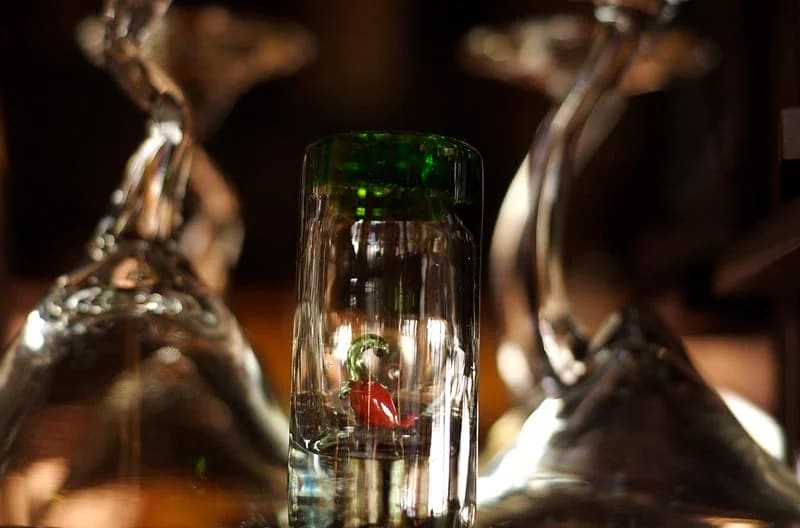
Skilled hands make almost all Mexican handicrafts, but in the blown glass industry, it is prioritized to have good and trained lungs.
The Mexican capital of blown glass is the Jalisco town of Tonala.
It also deserves the title of national craft capital for its pottery works, high-temperature ceramics, paper mache, wrought iron, and other specialties.
The elaboration of blown glass pieces is delicate because the artisan must blow a small amount of vitreous paste (molten glass) through a cane or tube over a meter long to give the material the desired initial shape.
The piece is then modeled with other tools and baked to achieve consistency.
This technique makes the famous Murano glass and pieces such as vases, lamps, ashtrays, glasses, bottles, tableware, and ornaments.
29. Escolásticas stone work

The first thing that catches the eye in the town of Escolásticas Queretaro is the soundscape produced by chisels, hammers, saws, grinders, and other tools used in stone working, from which some of the most elegant Mexican handicrafts emerge.
The stretch of road closest to the village is home to several workshops where stonemasons carve pieces of all sizes.
Most of the pieces are exported to the United States, Canada, and Europe.
From Escolásticas, you can get anything from a small decorative fountain to a 2-ton fountain to preside over a splendid garden, as well as animal sculptures, including horses, tigers, lions, crocodiles, rhinos, dolphins, and bears.
The main source of the stone is the local quarries, although blocks are also brought in from Jalisco, Yucatan, and Hidalgo, primarily to fulfill special orders.
Many people who build or remodel a house visit Escolásticas to enhance the interiors and exteriors of their property with the magnificent stonework of local stonemasons.
30. Sawdust rugs from Huamantla
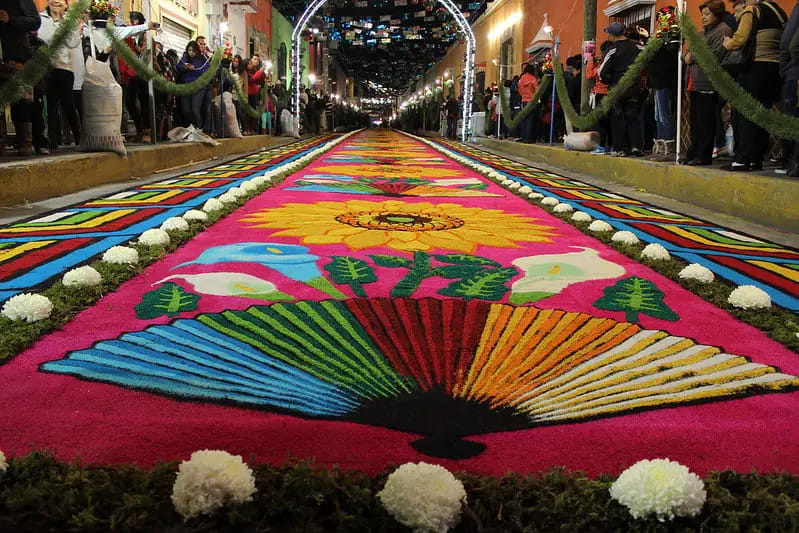
This is the only Mexican craft on this list that you won’t be able to take home, as they’re only temporary.
These colorful sawdust rugs are made in the Magical Town of Huamantla.
Huamantla is a town 48 km from the city of Tlaxcala, which obtained the distinction of “Pueblo Magico” for its religious and bullfighting traditions, its architectural heritage, and its natural spaces.
The mid-August festivities of the Virgen de la Caridad are Huamantla’s big annual event.
On the Night that No One Sleeps, August 14, the Huamantlecos make beautiful carpets of sawdust, sand, and flowers on the streets through which the Virgin will pass in procession, which leaves the temple at 1:00 a.m. on August 15.
They are handcrafted beauties of short duration that exemplify the artistic talent and religious devotion of the Tlaxcaltecos.
The other unmissable spectacle of the fair is the Huamantlada, a sort of Pamplona Sanfermin in Tlaxcala with bulls running through the streets and spontaneous bullfights.
31. Alebrijes
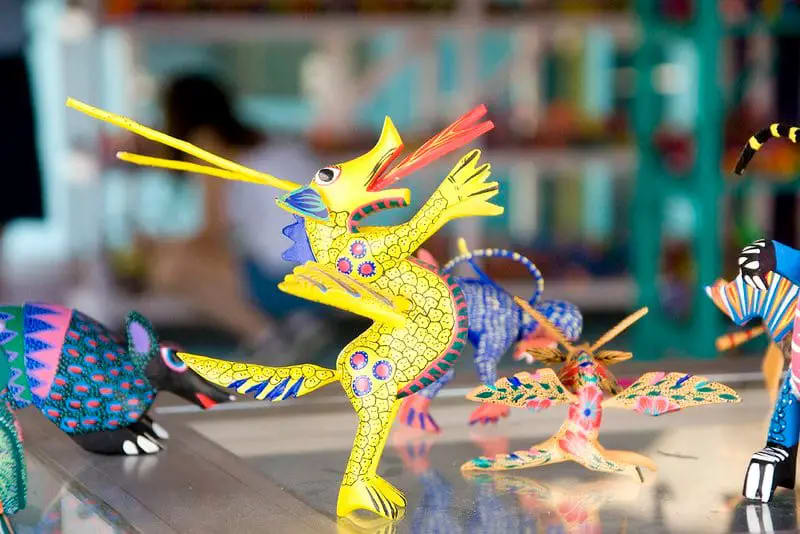
Alebrijes are colorful cardboard figures created in the 1930s by the Mexican cartonero Pedro Linares López after an illness in which he dreamed of fantastic figurines that he decided to bring to life.
Diego Rivera liked his work so much that the famous painter made commissions currently exhibited in the Anahuacalli Museum.
In the Oaxacan towns of San Antonio Arrazola and San Martin Tilcajete, they manufacture colorful alebrijes with copal wood.
Alebrijes are Mexican crafts with a highly imaginative component that the artisan can model from a more or less simple image to a tiny monster with several heads just born by a restless mind like master Pedro Linares López when he conceived them.
Other characteristics of alebrijes are their colorfulness and the attention to detail that requires a lot of patience.
Carving wood sculptures can also be a rewarding activity.
You can start by trying to carve a face out of dried coconut. A necklace or bracelet with beach shells can also be a good starting project.